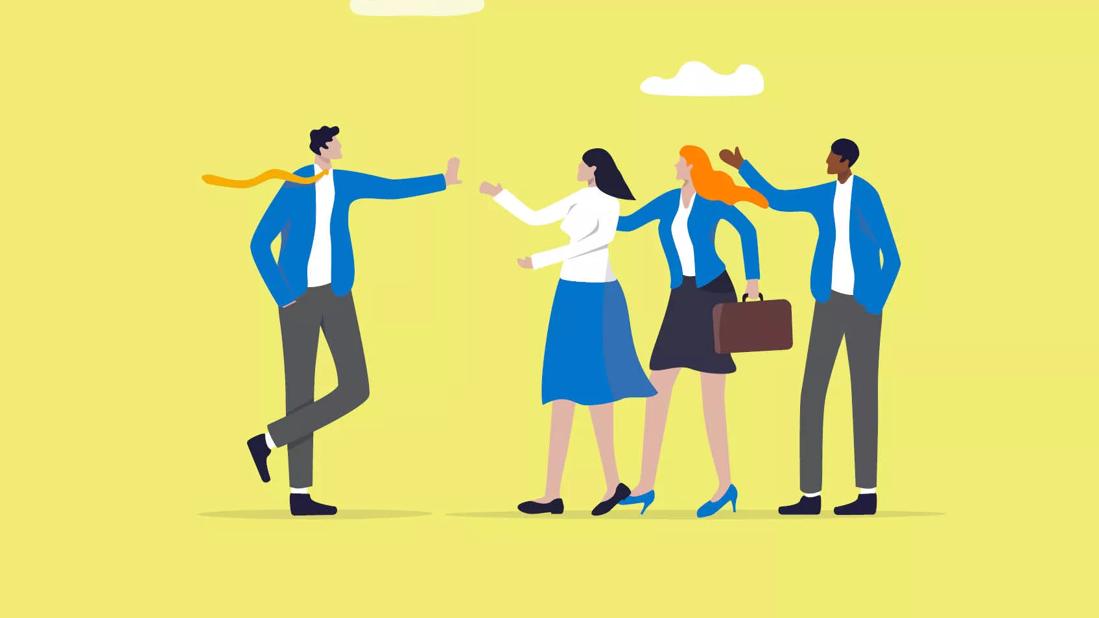Catching and responding to passive-aggressive behavior can be difficult

No one likes to feel personally attacked. But sometimes, people participate in passive-aggressive behavior that threatens our relationships and the way we think about ourselves. People can exhibit passive-aggressive behavior intentionally or unintentionally, and while sometimes, it happens in an effort to avoid conflict, someone may be passive-aggressive just to inflict harm.
Advertisement
Cleveland Clinic is a non-profit academic medical center. Advertising on our site helps support our mission. We do not endorse non-Cleveland Clinic products or services. Policy
Psychologist Kelly Deragon, PsyD, explains how to identify passive-aggressive behavior as it’s happening — and how to avoid doing it on your own.
Passive aggression is a style of communication in which you indirectly convey negative emotions like anger or frustration instead of addressing the situation openly and honestly. You can be passive-aggressive verbally or nonverbally through your body language or other physical actions. And while sometimes we can participate in passive-aggressive behavior unintentionally or subconsciously, it becomes particularly insidious when we’re passive-aggressive toward other people in order to cause harm or persuade others to give us what we want.
“You know it when you hear it because of the way it makes you feel,” says Dr. Deragon. “Most of the time, it’s an indirect way of expressing negative emotions. Someone might engage in passive-aggressive behavior when they’re saying or doing things that aren’t consistent with their true feelings. This may come across as sarcasm or the silent treatment.”
The most obvious example of passive-aggressive behavior can be experienced when someone is gaslighting you and being emotionally manipulative. But it can happen in smaller ways, too, even with people you love and care about or see every day.
Advertisement
Passive-aggressive behavior can occur in spoken and unspoken ways. Some examples include:
In the most sinister circumstances, someone might participate in passive-aggressive behavior because they want to go out of their way to “stick the landing” and inflict harm.
Other times, they may not want to directly confront you or be aggressively mean, especially in a public setting. But maybe they want to make it known that they’re displeased, dissatisfied or have negative feelings about you and the situation, and have you question your own understanding of what’s happening.
“Passive-aggressive behavior can bring up your own insecurities, especially if you’re experiencing it from a supervisor, a person in charge or someone you really care about,” says Dr. Deragon. “A lot of people will shrink down in their interactions when this happens because they don’t want others to know they’ve been hurt or cause further conflict, but at the same time, it makes you feel inferior and sometimes powerless.”
Someone may even be passive-aggressive unintentionally in order to avoid conflict or make things worse. If you have a problem saying “no” to someone, you might agree to do something or attend an event even when you know you don’t plan to follow through and never intended to in the first place. This could then lead to a series of unfortunate incidents where you appear to be distrustful or unaccountable.
Advertisement
“Passive aggression is not something we’re always aware of doing,” says Dr. Deragon. “Sometimes, people want to be polite and don’t want to disclose how they’re really feeling. It can also be a defense mechanism.”
Passive aggression can happen at home, online, in the workplace or even with complete strangers. And often, we pick up on passive-aggressive tendencies because we’ve learned the behavior from our parents, caregivers and other adults in our childhood.
“It can be a learned behavior. If you grew up in a house where passive-aggression and sarcasm happened often, then it becomes part of your own communication style,” explains Dr. Deragon. “For some people, that might affect their interpersonal relationships.”
Passive-aggressive behavior is anything that avoids direct conflict but still expresses negative emotions. When this happens, it can send mixed signals and make you question what’s really happening and how someone really feels.
“If something feels like it’s off, or if you’re feeling personally attacked and it happens again and again, that’s a good sign it’s passive-aggressive behavior,” states Dr. Deragon. “Often, if someone is exhibiting passive-aggressive behavior, other people who interact with that person will have similar experiences.”
Advertisement
If there’s a disconnect between what someone says and what someone does, and you’re leaving those conversations and experiences confused, disoriented or hurt, this may be a sign that you’re being faced with passive-aggressive behavior.
“The best way to understand someone’s intentions is to ask for clarification,” says Dr. Deragon. “If something feels like it’s off or we’re not getting the subtle undertones of why they’re acting that way, it can be really upsetting.”
You should never assume how someone else is feeling, even if it appears very clear by the way they speak or act. By asking someone to clarify what they said or what they mean by their actions, you can validate your own interpretations of what’s happening and come to terms with what they’re asking of you. You can also use this opportunity to explain how their actions make you feel and express the needs that you want met.
“It also makes that other person accountable for their actions and it might make them more aware of what they’re doing and how they’re making other people feel,” notes Dr. Deragon.
If you feel uncomfortable or unsafe calling out passive-aggressive behavior as it’s happening, it’s OK to take a breath and table the experience until you are ready to confront the person.
Advertisement
“Taking some space and revisiting it later is sometimes a good option,” says Dr. Deragon. “That allows some time for both parties to take a breath.”
Deep breathing exercises, meditation and yoga may also help you center yourself before you revisit the conversation.
“When someone seems as if they’re attacking you or being negative, there’s a tendency to want to respond in the same way and that’s not going to help the situation,” notes Dr. Deragon. “If someone is trying to get under your skin, you don’t want to make things worse and stoop to their level.”
In essence, setting healthy boundaries with people and addressing conflict before it gets worse is paramount in dealing with passive aggression.
If people you interact with are hurt by your actions, often defensive or seem to cower in response to the things you say, it might be a sign that you’re acting passive-aggressively toward other people.
“Maybe you show up late every time to a meeting or you storm around somebody, don’t make eye contact or intentionally exclude a person from a conversation,” offers Dr. Deragon. “In a way, you’re skirting interactions because of negative feelings toward them. When you’re cornered about your actions or confronted about your behavior, these may be signs that your behavior is becoming harmful to others.”
“Be honest with yourself,” advises Dr. Deragon. “Recognize what you want to say and how you want to act and try to figure out how to clearly voice your opinions because you’re not going to get your needs met if you’re not clearly communicating them.”
If you catch yourself giving short answers or you’re becoming unresponsive in the middle of a conversation, that may be a sign you’re not invested in the conversation. When this happens, you may want to take a step back and ask yourself, “What am I trying to communicate or what do I want to achieve with this interaction?”
Dr. Deragon says,
Recognizing your own vulnerability is important, and it can take years to unlearn this behavior. It starts with an awareness of your own behaviors and the words you use. If people want to make an improvement, they have to be willing to continually try. And if you slip up and make a mistake, that’s OK. You can work on it.
Although passive-aggressive behavior isn’t in itself a medical condition, it can be associated with other mental health diagnoses, like narcissistic personality disorder (NPD) or borderline personality disorder (BPD) (especially covert narcissism). But even if you’ve never been diagnosed with a condition, if your behavior is causing you concern, or if your relationships are becoming strained, you can ask your healthcare provider about starting therapy to figure out the root cause of your passive-aggressive behavior. Different kinds of therapy, like cognitive behavioral therapy, interpersonal therapy, dialectical therapy and social skills training, can help strengthen your social communication skills and empower you to make better choices.
“Therapy can help you focus on emotional regulation and interpersonal skills while also helping you explore your thoughts and feelings about difficult interpersonal experiences,” says Dr. Deragon. “Learning how to effectively communicate is one of the best tools we have.”
Learn more about our editorial process.
Advertisement

Fishing for compliments, provoking conflict and pouring on the melodrama are all ways of expressing an unmet need

By setting boundaries around how much you give, you can save your time and resources while also being a good person

Certain B vitamins, omega-3 fatty acids and a healthy diet can serve as complementary treatments for schizophrenia

Following your treatment plan, finding a community, staying active and maintaining a healthy diet can help manage this psychiatric condition

Whether it’s playing hooky or faking cancer, malingering behavior is always motivated by personal gain

Causes range from psychological conditions like PTSD to physical conditions like fibromyalgia

Always putting others’ happiness before your own can build resentment over time

Emotional changes, isolation and unusual behavior could signal the onset of the condition

The best parenting style balances enforcing rules and showing plenty of love

Tips include cutting back on sugar, focusing on exercise and managing stress

It can be harder to let go when you’ve invested time, energy and emotions — but it might be the healthier choice long term